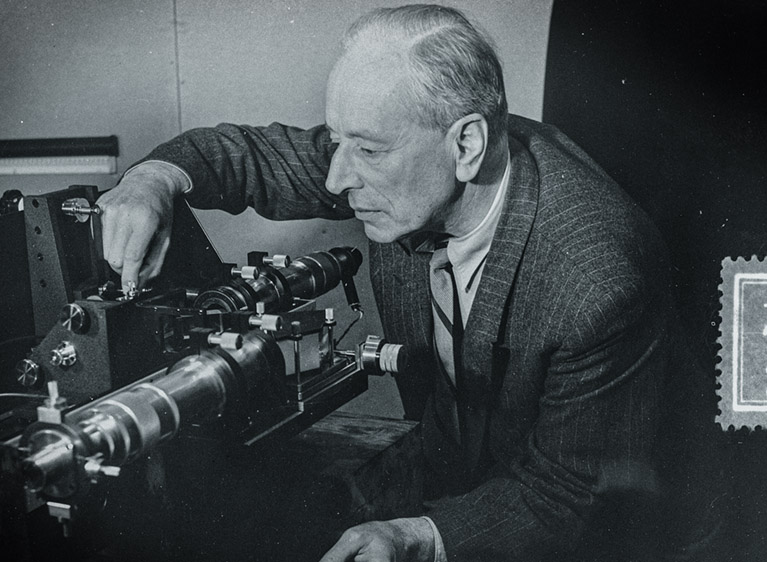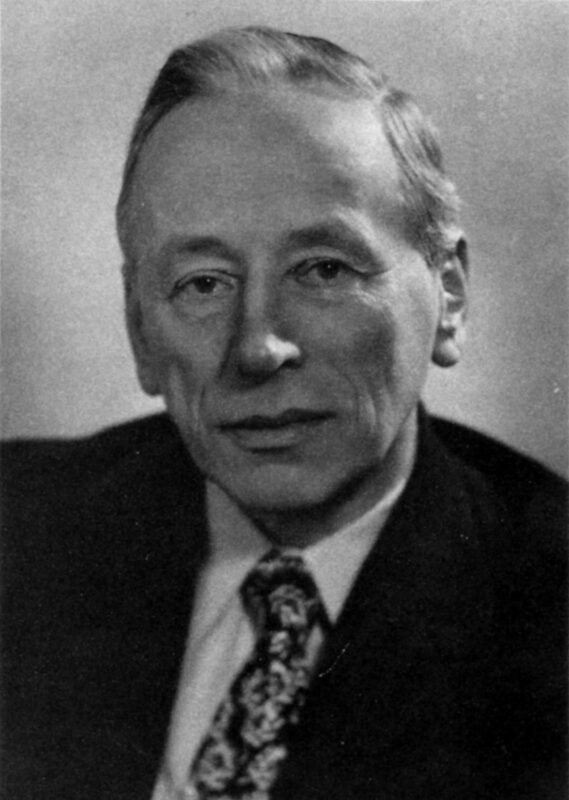
70 years after the first Nobel Prize
‘Zernike was a real-life MacGyver’
Groningen students see him everywhere: a lane, a bridge, a research institute, and even a whole campus were named after Frederik ‘Frits’ Zernike, the physicist who brought the Nobel Prize to Groningen in 1953 with his phase-contrast microscope. And if Ben Feringa hadn’t done the same in 2016, the newly completed Feringa Building would have been named Zernikeborg.
Yet students hardly have any idea who he was. ‘His first name is Frits, I believe’, answers science communication master student Onno when asked who Zernike is. All his fellow student Cecile can only produce is: ‘That guy the campus is named after.’ Master student in ecology and evolution Tim also shrugs. ‘No idea, actually.’
Who was Frits Zernike? Primarily, he was the first Nobel laureate of the UG; the man who designed a microscope in 1930 that made observing living cells possible for the first time. Until then, cells had to be stained before they could be studied, but that killed them. Now, scientists could also study the process of cell division.
It was a revolutionary discovery that gave a huge boost to the understanding of the micro world and was therefore rewarded with the Nobel Prize in Physics on November 4, 1953. Reason enough for the Faculty of Science and Engineering to organise a party this weekend at the event’s seventieth anniversary.
Hours of tinkering
‘Science was instilled in Zernike from a young age’, says university historian Annelies Noordhof-Hoorn. ‘His parents were teachers, and his father would practise his lessons on his children. His father also experimented a lot at home, and his mother was very good at taking things apart.’
It’s one thing to see that something is incorrect. Zernike also wondered: why?
Son Frits inherited their passion. He could spend hours tinkering in his room or on the roof. ‘Sometimes people would ask his mother what that noise on the roof was’, Noordhof-Hoorn says. ‘She would say that it was just Frits working.’
Zernike studied chemistry and physics, with mathematics as a minor. He quickly began winning prizes and became the assistant for another great figure in the history of the UG, astronomer Jacobus Cornelius Kapteyn. He started as professor of theoretical physics in 1920.
A short video item by the Swedish Nobel Prize Committee on Zernike.
Elevator
‘He was incredibly intelligent’, adds the University Museum’s natural sciences collection manager Jan Waling Huisman. He was in Paris at a conference when he got stuck in an elevator between two floors. Zernike saw who the manufacturer of the elevator was and knew the specifications. ‘After a few minutes of tinkering, he got the elevator working again. Like a real-life MacGyver.’
He was also a master of rethinking. ‘It’s one thing to see that something is incorrect’, Huisman says. ‘Zernike also asked himself why something was incorrect.’
And he continued to tinker. ‘His study in the laboratory on the Westersingel was a gigantic mess, but he knew exactly where everything was’, says Noordhof-Hoorn. ‘Zernike used absolutely everything. It was well known that when Zernike asked to borrow something, you wouldn’t get it back in one piece.’
Ghost lines
These two things together led Zernike to discover the principle of ‘phase contrast’. ‘It was by chance’, says Huisman. ‘He was working on technical arrangements in the lab to determine the refractions of light.’
Suddenly, Zernike saw a deflection, so-called ‘ghost lines’ that arise because light waves bend. ‘So he decided to investigate further.’
Zernike discovered the principle of ‘phase contrast’ by accident
That led him to phase contrast. ‘Light is a wave motion’, Huisman says. ‘When light passes through an object, some light waves change slightly.’ This deviation is usually very small. ‘But if you amplify that deflection, the contrast increases.’
This is exactly the principle of the phase-contrast microscope. Thanks to the amplified contrast, you can view transparent objects, such as cells, without using dyes, unlike a ‘normal’ light microscope.
Zeiss Werke
Zernike’s discovery would prove revolutionary for biology and medicine. Cell division and bacteria could finally be studied in detail.
However, not everyone was immediately enthusiastic about applying phase contrast in a microscope. There is the well-known story of Zernike’s visit to Zeiss Werke, a German microscopy company, where he tried to sell his discovery. ‘One of the senior scientists told me that if it were of any practical value, we would have discovered it long ago’, Zernike himself recounted in his Nobel Prize lecture in 1953.
He eventually collaborated with Caroline Bleeker, who had her own optics and instruments company. ‘He set to work to practically develop his discovery’, says Noordhof-Hoorn.
Loner
So, who was Frits Zernike? ‘I understand he was a loner’, Huisman answers. ‘Zernike was a practical man who was always working.’
Noordhof-Hoorn ponders. ‘Outwardly calm, inwardly moved’, she says. ‘Those aren’t my words, but they sum up who he was: a quiet man, but always occupied with his thoughts.’
It is important that people know who the Groningen Nobel laureate was, they both believe. Noordhof-Hoorn: ‘It’s high time for someone to write a biography on Zernike.’
Zernike’s anniversary will be celebrated with a sold-out symposium on Friday, November 3, and a public day on Saturday, November 4. Seventy microscopes will be on display at various locations in the province. Zernike’s grandson Frits will present a microscope from the family archive to the University Museum on Friday, which will be received by outgoing Minister of Education Robbert Dijkgraaf.
Was Zernike really the first?

While Frits Zernike may have developed the phase-contrast microscope in 1930, another Groninger – Jacobus Laurentius Sirks – came up with a microscope based on the same principle almost forty years earlier.
Sirks was the rector of the Stedelijk Gymnasium in Groningen but was also particularly interested in the properties of light. He conducted experiments in the attic of his house at the Herestraat.
These caught the attention of established natural scientists like Hermannus Haga, on whose recommendation he was awarded an honorary doctorate at the University of Groningen in 1892.
Interference microscope
A year later, in 1893, he came up with the very first interference microscope: a microscope based on the same principles as Zernike’s later phase-contrast microscope. He combined an interferometer, which splits light beams and recombines them via mirrors to measure small length differences, with an ordinary microscope.
Like Zernike’s microscope, he could use it to view translucent, living objects. He could also measure thickness differences that were tens of times smaller than with a regular microscope.
Vibration sensitive
But despite Sirks’ publication, no one was really interested. This was probably due to two things. Firstly, the device was so sensitive to vibrations that the experiments were only successful in Haga’s special, vibration-free laboratory. The other problem was the light source. Sirks used a sodium flame, which placed ‘extreme demands on the observer’s skill and endurance.’ Sodium is hot and burns extremely bright.
Sirks dismantled his revolutionary microscope after use. He needed the lenses for his next experiment.
CHRISTIEN BOOMSMA